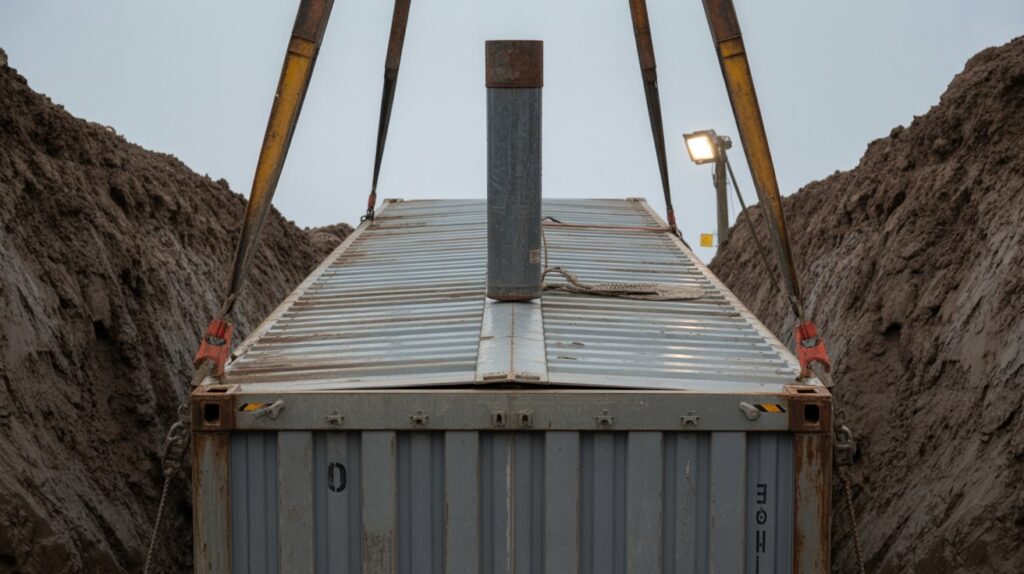Shipping containers seem like an ideal solution for underground bunkers—they’re strong, modular, and relatively affordable. But before you start burying a steel box in your backyard, it’s crucial to weigh the realities: while their rugged design handles shipping stresses, underground environments pose unique challenges like corrosion, structural pressure, and ventilation issues. So, does a repurposed container make a practical bunker, or is it a risky shortcut? Let’s dig into the pros and cons to find out.
Reasons to Consider Shipping Containers for Underground Bunkers
Shipping containers can be an innovative solution for building underground bunkers. Let’s look at why someone might choose them for such a purpose.
Cost Efficiency
One of the primary reasons people consider shipping containers for underground bunkers is their cost-effectiveness. Compared to other building materials, containers are relatively inexpensive. Even high-quality, brand-new containers are often less expensive than constructing a bunker using traditional building materials.
Structural Strength
Shipping containers are designed to endure harsh ocean conditions, meaning they are built to be strong. Their corrugated steel sides provide added strength and make them capable of holding a significant amount of weight, which is crucial if the container is to be buried underground.
Available Space
The size of shipping containers offers considerable room for a wide range of activities and storage needs. Whether you intend to use the space as an emergency shelter, storage facility, or living quarters, the spacious interior allows for various modifications.
Ease of Acquisition and Adaptation
Containers are widely available and can be readily sourced from numerous suppliers. Additionally, their structure offers a blank canvas that you can modify to suit your specific needs, whether you want to install interior rooms, electrical systems, or plumbing.
Rapid Deployment
Another advantage is the speed with which a container bunker can be installed. Once the container is on-site, the process of burying it and outfitting it for use is often quicker than constructing a bunker from the ground up.
Challenges and Drawbacks
Yet, while shipping containers have these appealing advantages, they also come with noteworthy caveats that you should be aware of.
Potential for Rust
Although made of corrosion-resistant steel, containers can still be subject to rust, especially once buried. The constant moisture from the ground can accelerate this process, potentially compromising the integrity of the structure if not properly treated.
Structural Limitations
Shipping containers are designed to bear weight on their corners, which can pose a problem when buried. The walls and roof might not withstand the lateral pressure of the surrounding earth, risking collapse if not properly reinforced.
Insulation Problems
Metal containers naturally conduct heat and cold, which can lead to discomfort without proper insulation. When using a shipping container as an underground bunker, you’ll need to invest in thorough insulation solutions to maintain a stable internal environment.
Ventilation Concerns
Given the confined space and air-tight nature of a sealed container, proper ventilation becomes critical. This requires installing systems to ensure sufficient airflow, preventing the build-up of moisture, CO2, and other potentially harmful gases.
Permitting and Legal Hurdles
It’s essential to understand the local zoning laws and building codes, as burying containers may require permits and could potentially breach regulations. Legal challenges could arise if the container is not in compliance with local requirements.
Preparing Shipping Containers for Underground Use
If you decide that shipping containers are the right fit for your bunker, preparation is key. Let’s consider steps to optimize their performance.
Enhancing Structural Integrity
To counteract the pressure exerted by the earth, reinforcing the container is critical. Employing steel beams and additional welding at key stress points can help maintain the structural integrity of the container when underground.
Rust Prevention Methods
Applying anti-rust coatings and utilizing waterproof materials around the container can mitigate rust risks. Regular inspection and maintenance will also play a vital role in extending the lifespan of the bunker.
Effective Insulation Solutions
Consider robust insulation techniques, such as spray foam or rigid foam board, both of which can help regulate the temperature within the container. These materials can not only keep the space comfortable but also extend the life of the structure.
Installing Proper Ventilation Systems
Mechanical ventilation systems, such as air exchangers, will ensure a fresh supply of air and mitigate the risk of moisture problems. Consider investing in quality air filters to maintain the air quality inside.
Navigating Legal Requirements
Before initiating your project, consult with local authorities to ensure adherence to zoning laws and safety regulations. Acquiring the necessary permits is fundamental to avoiding costly fines or the potential dismantling of your project.

Conclusion: Weighing the Pros and Cons
Utilizing shipping containers as underground bunkers is a fascinating concept with significant potential, yet it demands careful consideration. On the one hand, containers offer economic, practical, and accessible solutions, but only when the constraints of their use are appropriately managed. For every advantage, there is a corresponding challenge that requires diligent planning and execution.
Engaging with professionals experienced in underground construction, conducting thorough research, and prioritizing safety considerations will play essential roles in any successful project. If these factors align with your objectives, shipping containers may very well serve as an innovative and viable option for your underground bunker needs. Ultimately, the decision lies in balancing the pros and cons to best suit your specific requirements and visions for an underground sanctuary.
By evaluating these aspects carefully, you can make an informed decision about whether shipping containers make good sense for your next underground bunker project. With adequate preparation and awareness of the challenges involved, they could provide a secure and functional solution tailored to your needs.

